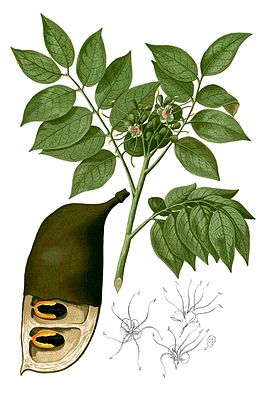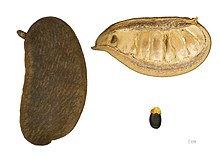Afzelia
| Afzelia | ||||||||||||
|---|---|---|---|---|---|---|---|---|---|---|---|---|

Afzelia rhomboidea , illustration |
||||||||||||
| Systematics | ||||||||||||
|
||||||||||||
| Scientific name | ||||||||||||
| Afzelia | ||||||||||||
| Sm. |

Afzelia is a genus in the subfamily of caesalpinioideae (Caesalpinioideae) within the family of the Leguminosae (Fabaceae). The approximately 14 species are native to tropical Asia and Africa.
description
Afzelia species grow as trees . The alternate, stalked leaves are paired feathered with a few pairs of pinna leaflet . The tiny stipules fall off early.
The terminal, paniculate inflorescences contain more or less durable, somewhat thick, egg-shaped, uncolored bracts and bracts . The stalked flowers are hermaphroditic with a double flower envelope . There is a cup-shaped to funnel-shaped flower cup and four leathery sepals . Only a large, nailed petal is recognizable, with an obovate to semicircular and partly two-lobed plate ; the other petals are at most rudimentary . There are seven to eight fertile stamens . The long stamens are partially fused or free at their base. The anthers are egg-shaped or oblong. The two staminodes are small. The only partly or long gynophor stalked and medium-sized ovary contains few to many ovules . The long stylus ends in a heady, small scar.
The slightly flattened legume is more or less elongated, woody, thick, double-fan, and septate between the seeds. The ovoid to elongated seed, with a Arillus have two fleshy, more or less flat cotyledons ( cotyledons ) and a straight embryo, but no endosperm .
use
The wood of the West African species known as doussié , noble cherry or brilliant cherry is very resistant to fungi .
The high density requires good thermal conductivity , so that the wood is particularly suitable as a covering for heated floors . In addition to parquet , it is used for stairs, doors and windows, for tables and in boat building. The wood is initially yellowish to light brown in color and later turns reddish brown. It must be dried slowly, otherwise it will warp. Like teak and merbau , it is resistant to fungi and insects and therefore does not require any special protection.
The hardness is significantly higher than that of teak or oak . Also velodrome farmers use afzelia because of the low frictional resistance and the resistance as a sheet covering for open cycling tracks.
The biologically related Merbau is very similar in properties, color and structure .
Systematics
The genus Afzelia belongs to the tribe detarieae in the subfamily Caesalpinioideae within the family of Fabaceae . The first publication of Afzelia was made in 1798 by James Edward Smith in Transactions of the Linnean Society of London , Volume 4, page 221. A synonym for Afzelia J.E. Smith is Pahudia Miquel .
The genus name Afzelia honors the Swedish botanist Adam Afzelius .
There are about 14 afzelia - types :
- Afzelia africana Sm. Ex Pers. : Their wood is called Lingue / Papao . It occurs in tropical Africa.
- Afzelia bella Harms : It occurs in tropical Africa.
- Afzelia bipindensis Harms : Their wood iscalled Doussié . It occurs in tropical Africa.
- Afzelia bracteata bird ex Benth. : It occurs in tropical West Africa.
- Afzelia pachyloba Harms : Their wood iscalled Apa . It occurs in Cameroon, Gabon, Nigeria and the Congo area.
- Afzelia peturei De Wild.
- Afzelia quanzensis Welw. : Their wood is called chanfuta / pod mahogany . It occurs in tropical and southern Africa.
- Afzelia rhomboidea (Blanco) S. Vidal : It occurs in Indonesia, Malaysia and the Philippines.
- Afzelia xylocarpa (short) Craib : Their wood is called Makamong . The home is China, Cambodia, Laos, Myanmar, Thailand and Vietnam.
No longer counted in this genus:
- Afzelia palembanica (Miq.) Baker => Intsia palembanica Miq.
swell
- Dezhao Chen, Dianxiang Zhang , Ding Hou: Afzelia in der Flora of China , Volume 10, 2010, p. 24: Online. (Section description, distribution and systematics)
Individual evidence
- ↑ a b c d e f g h i Afzelia in the Germplasm Resources Information Network (GRIN), USDA , ARS , National Genetic Resources Program. National Germplasm Resources Laboratory, Beltsville, Maryland. Retrieved March 30, 2017.
Web links
- World Conservation Monitoring Center of the United Nations Environment Program: Datasheet: Afzelia bipindensis . ( Memento of March 8, 2001 in the Internet Archive ) (About one of the species, English)
